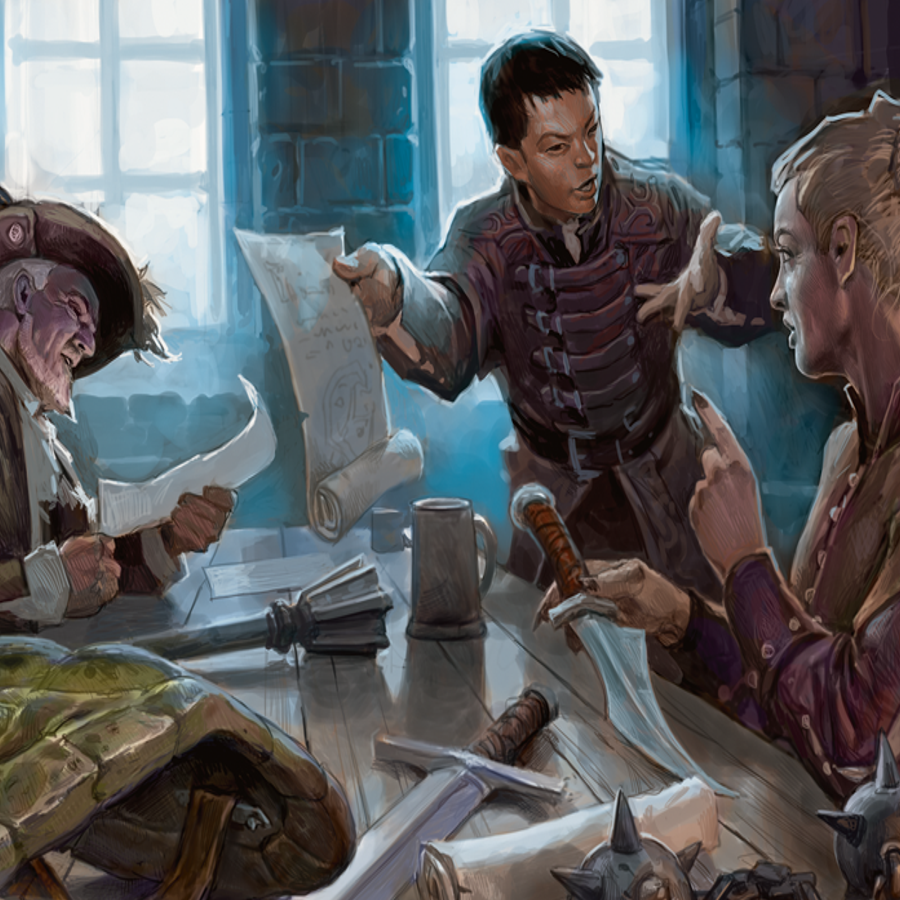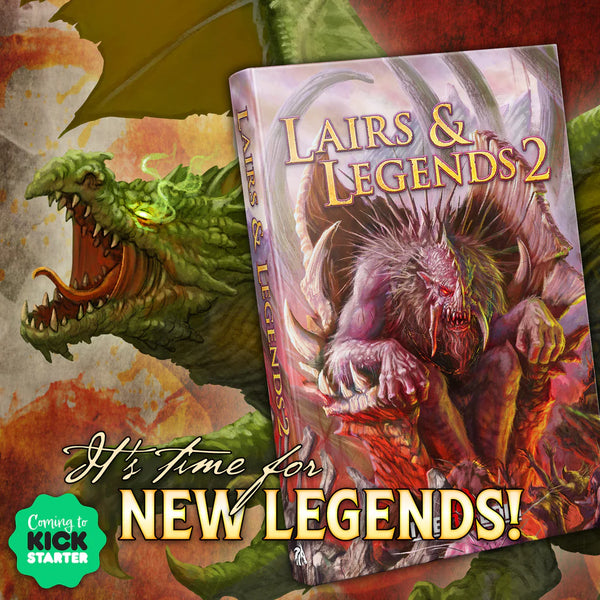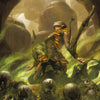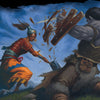Why Your D&D Players Keep Quitting Your Game

By Luke Hart
Anyone who’s been a dungeon master for any length of time has had D&D players leave their games, sometimes amicably and sometimes not. But it happens to the best of us. What we’re talking about today are the various reasons WHY players might leave your TTRPG game along with suggestions for what you might do about it . . . ideally BEFORE they actually leave.
By the way, running awesome games with in-depth lore, deadly traps, and terrifying monsters doesn’t have to take hours of prep! Lairs & Legends 2 and Loot & Lore 2 have everything you need! Hand-crafted by a team of professional game masters to make it as easy to use as possible, they are an anthology of game master resources to fuel you for years to come.
Watch or listen to this article by clicking the video below.
1. Logistical Issues
Scheduling. Let’s just get this out of the way. Scheduling is the number one game killer. If your game is at a time that doesn’t work for a player, they’re out. It’s as simple as that. But that’s not usually how you lose players. Generally speaking, the group agrees on a time that will work for everyone, and then things just keep coming up where one player here and there just can’t make a session. And, if the group isn’t willing to keep playing when a player can’t make a session, you tend to fall into a scheduling spiral of death where you are constantly skipping sessions or rescheduling . . . and eventually, it becomes an absolute nightmare. Players might get fed up over it and look for other more consistent groups they can play in, and in the worst-case scenario, the entire group fizzles.
The single best thing you can do is to play as long as you have at least three or four players who can make it. This avoids the entire death spiral and actually encourages players to make the game because they know they’ll miss out if they don’t. Having a recurring schedule on the same day and time every week or two weeks is the other key solution to avoiding this problem.
Next, set expectations. You’ll usually do this during a session zero in a conversation with your players. You want to set expectations about a variety of things, such as the game schedule, obviously, and the type of game you are running. For instance, what content is off-limits in the group, and what kinds of content do people want to see? What happens to a player’s character when they aren’t at a game session? Are we following the rules as written, or are there house rules? How do we handle rule discussions or arguments? What do we do if there is a problem during the game? Setting expectations for the group during your session zero is helpful, but if an issue comes up in the middle of the campaign, do it at your next game session.
2. Game Master Issues
Yeah, this is where it’s YOUR fault. I think it’s easy for us to sometimes blame all the problems in our games on the players, but it’s also important for game masters to own up to the crap they bring to the table that causes players to nope out. Now, I’m not going to give you a master list of all the dysfunctional GM issues that exist because, frankly, I’ve spoken about many of them before, and there are actual channels here dedicated to horror stories—many of them about GMs.
However, here are some of the big ones that can drive players away: removing player agency, railroading, allowing toxic behavior (or being the one displaying toxic behavior), the so-called GM vs. Player mentality, favoritism, using GM PCs, the GM telling a story instead of running a game, and lack of commitment from the GM. The latter—lack of GM commitment—usually manifests in the form of not preparing adequately for the game. Of course, most GMs won’t admit to this; instead, they’ll justify their lack of prep with trite sayings, such as: “The best-laid plans of mice and GMs oft go awry,” or “No plan survives first contact with the players.” Of course, players often throw wrenches in the plan, but the more prepared you are, the better able you’ll be able to react to those wrenches.
However, I believe there is one game master issue that doesn’t get enough press, probably because people just don’t feel comfortable talking about it. And that’s that your game just might not be that good. Four-plus hours for a game session, one a week or twice a month, is a big time commitment, and folks will only do that if they’re enjoying the game. Now, a lot of factors go into a game being fun and enjoyable—and yes, the players contribute to this in a large way—but we cannot ignore the fact that perhaps the largest factor in a good game is the game master.
Now, I’m not trying to make you feel bad by telling you this; I’m not trying to browbeat you and tell you it’s your fault. And we certainly can’t ignore the fact that what constitutes a “good game” is subjective; what I think is a good game someone else will hate, and vice versa. But my point is this: as a game master, you should be committed to improving your game little by little each time you prepare an adventure and each time you run a game session. The better you can make your games, the more likely everyone will enjoy themselves, and your players will stick around.
The good news is that there are tons of resources out there for GMs to learn from. Obviously, my channel is filled with GM advice on a variety of topics, and my team and I are publishing the Secret Art of Game Mastery. But there are other amazing resources out there, such as this book, So You Want to Be a Game Master by Justin Alexander, which I’m personally reading right now—and learning a lot, by the way. I also think Arbiter of Worlds has a lot of good information in it. So, the resources are out there; you just need to behoove yourself of them.
I think one of the best ways you can work to improve your game is by gathering feedback from your players. Every three months, I send my players a survey that asks them three questions: One, rate this game from 1 to 5. Two, what is something about the game you enjoy that I should keep doing? Three, what is something you dislike that I should stop doing? Four, what is something that I should start doing? Then, I evaluate the feedback, often talk to the group about certain points, and work to improve in any areas that I need to grow in. However, you can also evaluate your own behavior and game sessions. After each session, think back on the game. Were your players smiling, laughing, having fun? Were they bored? How well do you think you did? Were you prepared? What could you do better in the future?
3. Common Game Issues
Sure, why not? Let’s go over some of the most common issues games typically have.
The first issue is games that are too easy or too difficult. Some players like beer and pretzel games where they take names and kick butt and cakewalk the bosses; others prefer to be challenged. Clearly, you can talk to your players to see what they prefer, but you’ll probably find that you’ll have a variety of preferences in your group. Thus, I’ve found the best solution is to simply have a variety of difficulties in your encounters and adventures; sometimes it’s easy, sometimes it sits somewhere in the middle, and sometimes it’s downright hard.
Too many players! Guys, I’m telling you, I’m telling you. It might be exciting when you have twelve people who want to play, and you’re like, THIS IS AMAZING! I need to buy a bigger table! But experientially, most large groups suffer from a variety of problems—chief of which is BOG. And by this, I mean that everything takes forever, gameplay is slow—especially combat—decision-making is practically impossible, and players often find themselves waiting forever to participate because there are just so many people playing. This can lead to a boring game where players lose interest. Now, the good news (kind of) is that this could lead to players leaving the game, reducing the headcount and thus improving the game. Except that you could have players you really like leave, and other players that you wish would leave staying instead.
Next, constant rules arguments. Sometimes, this is rooted in the game master just not knowing the rules, and other times, it’s rules lawyers who just want to get their way. Regardless, arguing over the rules constantly can make any game miserable. My house rule is this: I may solicit—and often do—feedback from players on a ruling and consider what they have to say, but once I make a decision, we need to abide by it and let the matter drop so that we can get on with playing the game.
Next, we have ignoring certain pillars of the game. There are three pillars in an RPG: combat, exploration, and social interactions—people often refer to the last one as “roleplaying,” even though the entire game is roleplaying, but I’m not going to rant about that now. I promise I’m going to control myself. The thing is, when you don’t include all the pillars, your game just isn’t going to be as interesting and fun as it could be. It won’t appeal to a variety of play styles and preferences, which you’ll likely have represented among your players. Now, if you want to learn more about the three pillars, check out my video titled “The 3 Pillars of a Successful D&D Game”.
And then we have long combat slogs. Now, to be clear, having a long combat time does NOT make it bad combat. I routinely have combats in my high-level D&D game I run for patrons that last 2 or 3 hours—usually boss fights—and the players tell me that they really enjoy them. So, a long combat does not a slog make. Instead, a slog is a combat that is both long and BORING. To overcome this, you can do two things: try to make combats faster, though that isn’t always possible. And then, of course, you can make your combats more interesting.
The final most common game issue, in my opinion, is a simple difference in preferred game styles. Now, to a certain extent, you, as the game master, can tailor your game so it appeals to a variety of play styles. That’s exactly what I try to do in my games. However, if there is a fundamental disconnect on game style, some players won’t enjoy the game as much as they otherwise might and may leave. For instance, you may prefer to run a gritty game where death is always waiting around the corner, but some players may prefer the happy, fluffy, fey unicorn bunnies game where no one ever dies. Neither is right nor wrong—it’s 100% a matter of preference.
Now, unfortunately, there may not be too much you can do about differences like this except wish them the best and hope they find a game that suits their tastes. My personal take on this is that you, as the game master, should run a game that excites you and find players who also want to play that game. It shouldn’t be too hard; game masters are in short supply, and players are a dime a dozen. If you have a particular group of friends you really want to play with, sure, you may make some concessions to make sure the game is enjoyable for them, but don’t completely compromise to the point where you, as the GM, don’t like the game. At that point, your game will probably be doomed to failure. Game mastering is a labor of love; if you aren’t enjoying it, the game will suffer.
4. Player Conflicts
These are conflicts that occur directly between players themselves. A typical conflict you’ll run across is players who can’t agree on what they want from the game. For instance, you could have a murder-hobo who wants to kill everything in their path and another player who loves acting in character and wants to converse with everything. Those two players are quite likely to butt heads, and if they don’t find a way to accommodate what each other wants from the game, there are likely to be disagreements, arguments, and elevated feelings. Yes, this is similar to players having different playstyles, but the distinction is that the difference leads to direct conflict.
The next source of player conflict is when one player steps on another player’s fun. This can happen when a player is taking the game too seriously or not seriously enough. Or it might be a rules lawyer who gets bent out of shape when the game master is attempting to make an exception to the rules to allow another player to do something cool in the game.
And then you have selfish players who hog the limelight and essentially don’t allow other players to play the game much, or the lone wolf players who refuse to stick with the party and de facto force the game master to run two games simultaneously, which results in more work for the GM and less playtime for the rest of the players (and for them, too). Finally, cheating can result in some heated player conflict.
So, what’s the solution? Well, no matter what the permutation of direct player conflict is, the steps a game master should take are fairly universal. They involve doing what most folks are loath to do: talking to the people involved in the conflict and trying to resolve the issue. In some cases, it will be clear which player is the source of the conflict—such as cheating or rules lawyering—and you can have a conversation privately with them. Explain what the situation or issue is and how it’s making others feel, and ultimately request that the behavior be changed. You want this to be a conversation where you can get their version of events or their point of view on things; you don’t just want to rattle off a list of issues and then an order to change. That probably won’t go over too well.
Now, in cases involving more than one player, it may make sense to talk to everyone involved all at once. That way, you can facilitate a conversation with all and guide things to a resolution everyone is satisfied with. Of course, in some cases, it might make sense to talk to the ENTIRE group about what’s going on.
And an important point here: try to get to the ROOT of whatever issue you’re dealing with. Remember that the actual issue you’re seeing may be caused by something else. If that something else—that root cause—isn’t dealt with, the issue may persist, or even if it goes away, another issue may arise because the root cause is still there. For instance, I once had a player who LOVED “waking up” other rooms in a dungeon when the group was already in combat, which often added more combatants and made things harder or even deadly. Now, I still don’t know for certain why he was doing that, but my friend Joe came to me one day and gave me his theory. Joe explained that it was probably because that player was upset that he wasn’t getting his way in the game, and it was his way of punishing everyone else.
Because here’s the thing: the cost of doing nothing could be that one of the players involved in the conflict leaves your group. And, frankly, the chances are high that the player causing the issues won’t be the one to leave. No, the other player will. And then you’re left with a player still causing problems and potentially driving away other players. No, fellow game master, it’s imperative that you take action before things go sideways and your group begins falling apart.
5. Interpersonal Issues
Next, we have a variety of interpersonal issues that may rear their heads and cause conflict at the table. You could have basic personality conflicts, age or generational differences, a falling out between friends, or couples drama—that’s a really fun one to deal with—drunk or high players, people who show a lack of respect, a manifestation of -isms (such as sexism or racism) or hygiene issues. Now, though any of these are challenging—and sometimes very awkward—to deal with, the good news is that the basic approach is the same as dealing with player conflicts: talking with people.
It’s Time for New Legends!
Lairs & Legends 2 and Loot & Lore 2 are the ultimate game master resource! These two massive books put an anthology of everything you need to run amazing games for YEARS at your fingertips.
- Over 30 Adventures
- 30 Stand-Alone Encounters
- More than 100 Monsters
- 6 New Rule Sets
- And much more!
These books are written to make running the game easy for new and veteran GMs. Each resource is built with intuitive formatting, clear wording, and evocative art. You’ll never again have to dig through dense paragraphs to find critical details you need during a live session.
These 5e resources are designed to scale to your needs; whether it’s a quick drag-and-drop trap to add some spice to your session or complete adventures that span levels 1 to 20. The sky’s the limit with what your games can become with Lairs & Legends 2 and Loot & Lore 2.
-
Posted in
Game Master How-To Articles







